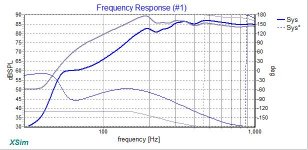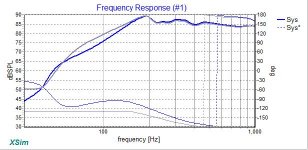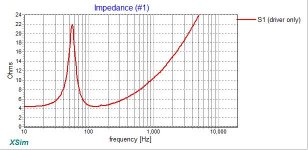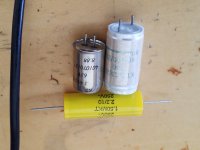The BBC said that we need 1/19 f19 in the Fourier series to make a reasonable square wave. It's in truth an infinite series of odd harmonics where the fraction and the harmonic are the same number.1/3 f3 + 1/5 f5 + 1/7 f7 .......1/19 f19. A triangle wave being similar except the number squares 1/9 f3 ...My similar JLH did about the same.
As to the capacitor. Panasonic FC are cheap and good. 2 x 2200 uF 35 V should be good. That's 4400 uF. If you are using it for mid range you can use it as a simple crossover. 10 uF or whatever.250 V polyester being very ok. If using 2200 uF buy a few spares. If 2200 or 6600 uF sounds best it's personal. 6600 uF might be impressive or boom depending on the speakers. Less can be more. I think that value is available. 1000/35 multiples if not.
That waveform very impressive. I had about 300 kHz which is still impressive.
As to the capacitor. Panasonic FC are cheap and good. 2 x 2200 uF 35 V should be good. That's 4400 uF. If you are using it for mid range you can use it as a simple crossover. 10 uF or whatever.250 V polyester being very ok. If using 2200 uF buy a few spares. If 2200 or 6600 uF sounds best it's personal. 6600 uF might be impressive or boom depending on the speakers. Less can be more. I think that value is available. 1000/35 multiples if not.
That waveform very impressive. I had about 300 kHz which is still impressive.
Last edited:
Thanks Nigel.
I am also using Panas FC actively in my hobby builds, excellent for the money. However, for this application I was thinking about something more exclusive, as Rifa PEG, but I am not sure how much of the effect this cap has on sound. I have already quite high grade film cap used as bypass. There are some 122 and 124 peg caps available on ebay, first is cheaper.
I am also using Panas FC actively in my hobby builds, excellent for the money. However, for this application I was thinking about something more exclusive, as Rifa PEG, but I am not sure how much of the effect this cap has on sound. I have already quite high grade film cap used as bypass. There are some 122 and 124 peg caps available on ebay, first is cheaper.
Member
Joined 2009
Paid Member
... 6600 uF might be impressive or boom depending on the speakers. Less can be more.
Nigel, are you saying that there is a case for fine-tuning the output capacitor for the speaker the amplifier is intended to be used with ? Is this a case of using the value of the capacitor as a form of EQ to allow the impact of the room or other speaker behaviours to be dealt with at the amp ? And is is still true to say, that no tweaking should be needed if you already have your speaker and room set-up optimally ?
..
I'm wondering now, having only just thought about it if I need a pre-amp, I'm going to make the JLH 1969 version. My input thingy is an LG DVD/CD player £35.00 will play anything and makes my modded CD723 which refuses to play anything I create myself sound like Monty Python's Parrot.
Cheers
You can check the output impedance and output voltage of your source, but my guess is that it should work without problems. If you don't have a volume control, you could use a passive potentiometer at maybe 10kohm. Others please correct me if I'm wrong.
Nigel, are you saying that there is a case for fine-tuning the output capacitor for the speaker the amplifier is intended to be used with ? Is this a case of using the value of the capacitor as a form of EQ to allow the impact of the room or other speaker behaviours to be dealt with at the amp ? And is is still true to say, that no tweaking should be needed if you already have your speaker and room set-up optimally ?
It's not really important why although your example is very likely the big reason. I would say the exact value seeing as a choice to be made will be the larger factor. The quality above a certain level secondary.
It always surprised me how good the sound of capacitor coupled amplifiers can be. Sudgen A48, Quad 303, Armstrong 621, Nytech 252. All have very basic capacitors yet have very similar qualities to valve designs.
If an amplifier has negative feedback after the capacitor listening tests become more interesting. Larger almost seems to be worse until you realise what's happened. The bass is tighter and deeper.
Higher voltage capacitors often are what audiophile types are based on. The tan theta is better. It's a byproduct of resisting flashover. I am not sure I like bypassing low grades with smaller higher grades. A 10 uF Panasonic FC the exception. BBH Aerovox slit foils were good. The slits diffuse eddy currents. Invented by Dennis Morecroft of DMN.
Nigel, are you saying that there is a case for fine-tuning the output capacitor for the speaker the amplifier is intended to be used with ? Is this a case of using the value of the capacitor as a form of EQ to allow the impact of the room or other speaker behaviours to be dealt with at the amp ? And is is still true to say, that no tweaking should be needed if you already have your speaker and room set-up optimally ?
Yes, there is a tweak to adjust bass response with series capacitors. I think this mostly applies to small (undersized) sealed boxes with fairly high Qt, the effect with a proper sized capacitor can be better low end extension, but also more current from the amplifier. I have no practical experience about this, only read some stuff about it.
You can simulate this with crossover simulation programs (like Xsim). Also using a small cap will generally create problems around the resonance frequency of the driver. The attentuation will not be a 6dB slope, but the higher impedance at resonance will create a bump in the frequency response.
Below are examples from X-sim. The grey curve is without cap (reference) and the blue is the response with cap in series. 82 & 400uF. I also included a graph of the woofer impedance curve.
Attachments
I got very good results with quad 303 capacitors 10000uF + bypass 1/10 em + bypass 1/100 em.
I tried dozens of capacitors (brand and values) on my jlh and there it seems that the region 4.7k to 6.6k uF is the most efficient and without bypass.
ditto for the preamp, I tried many, really many, tubes, transistors, op amp and also several simple potentiometer from 10k to 500k.
the best results for me have been with simple buffers whether it be lamps or op amp.
with preamp + gain, I got noise and loss of information,
with potentiometer I always lost information at the top or bottom of the spectrum.
I have several amp with output capacitor (quad nytech jlh ACA kenwood scott and more and more) it seems that only the jlh refuses a preamp with gain (except the AGI 511) which was wonderful but unfortunately not mine.
I remain convinced that the jlh requires simplicity all the way and including with the speakers.
I should have noted my trial and error since I had the chance to listen to them all for 10 years now with exactly the same configuration in the same room with the same CDs.
now it's over, i sold my house and dismantled all my systems while waiting for a new house in the next few months, so i could resume.
As Nigel said so well, the JLH is like the Citroen 2cv, it is very hard to remove or add a piece without unbalancing the whole, however if we respect what it was designed for , you will never fail.
again (yes I ramble) I have and I really had a lot of amplifiers and others, enough to no longer be able to count, the jlh (in several forms) always stays at home and is used (in normal times) every week.
I tried dozens of capacitors (brand and values) on my jlh and there it seems that the region 4.7k to 6.6k uF is the most efficient and without bypass.
ditto for the preamp, I tried many, really many, tubes, transistors, op amp and also several simple potentiometer from 10k to 500k.
the best results for me have been with simple buffers whether it be lamps or op amp.
with preamp + gain, I got noise and loss of information,
with potentiometer I always lost information at the top or bottom of the spectrum.
I have several amp with output capacitor (quad nytech jlh ACA kenwood scott and more and more) it seems that only the jlh refuses a preamp with gain (except the AGI 511) which was wonderful but unfortunately not mine.
I remain convinced that the jlh requires simplicity all the way and including with the speakers.
I should have noted my trial and error since I had the chance to listen to them all for 10 years now with exactly the same configuration in the same room with the same CDs.
now it's over, i sold my house and dismantled all my systems while waiting for a new house in the next few months, so i could resume.
As Nigel said so well, the JLH is like the Citroen 2cv, it is very hard to remove or add a piece without unbalancing the whole, however if we respect what it was designed for , you will never fail.
again (yes I ramble) I have and I really had a lot of amplifiers and others, enough to no longer be able to count, the jlh (in several forms) always stays at home and is used (in normal times) every week.
for those on a budget who want to listen to music I can recommend this.
a jlh 69 well assembled with above all a good power supply.
a philips cd player with a cdm9 / 11 mechanism and a dac tda 1541 (genre cd471 or similar).
you just pick up the signal directly on the tda1541 with an I / V resistance from 50 to 80 ohm and you go straight in there:
Pre-AMP Amplifier Board KIT Tube 6N2 SRPP Good for DIY - Free Shipping - ThanksBuyer
with good russian 6N2P-EV (6H2П-EB) pair.
then in your jlh on which you will have a good pair of two-way speakers.
there you will have music
a jlh 69 well assembled with above all a good power supply.
a philips cd player with a cdm9 / 11 mechanism and a dac tda 1541 (genre cd471 or similar).
you just pick up the signal directly on the tda1541 with an I / V resistance from 50 to 80 ohm and you go straight in there:
Pre-AMP Amplifier Board KIT Tube 6N2 SRPP Good for DIY - Free Shipping - ThanksBuyer
with good russian 6N2P-EV (6H2П-EB) pair.
then in your jlh on which you will have a good pair of two-way speakers.
there you will have music
Can't help going off topic a bit..
I find that I sometimes listen to music I don't really like, just because it's a good recording, and on the other hand I don't listen to some of the music I like just because the recording is too bad.. Sometimes my ears just can't stand the bad sound.
I find that I sometimes listen to music I don't really like, just because it's a good recording, and on the other hand I don't listen to some of the music I like just because the recording is too bad.. Sometimes my ears just can't stand the bad sound.
My main point was to forget the capacitor quality and seek the correct value. Many capacitors made for switchmodes should be OK and cheap. Remember an amplifier is a signal modulated power supply. Every capacitor is in the signal path . Especially ones that aren't. It's called Kirchoffs laws. A local decoupling capacitor is an example. The JLH is so simple that experiments are obvious when tried. This if you are honest with yourselves is more important than excellent verses ultra excellent transistors. The original JLH transistors were better than typical 2N3055H. One wants > 10 mHz gain > 100. BDY56 was the one in the 1970's.
I find solid core thin cables make bad music OK. Also makes wonmderful music wonderful. I have no idea why people spend big money on cables. Thoese guys took a cheap idea and sold it for life changing for them money. Much as I think Nordost is great cable I feel it is just the science of a single core. Solid core should need 10 000 uF. Cable <0.6 mm dia. Bass is strong if asking. I use about 3 metres if possible. My cable is 0R3.
I find solid core thin cables make bad music OK. Also makes wonmderful music wonderful. I have no idea why people spend big money on cables. Thoese guys took a cheap idea and sold it for life changing for them money. Much as I think Nordost is great cable I feel it is just the science of a single core. Solid core should need 10 000 uF. Cable <0.6 mm dia. Bass is strong if asking. I use about 3 metres if possible. My cable is 0R3.
Hi.
I see you're digussing capacitors, I have been thinking, what makes up a good input dc cap?
In my jlh I just put the yellow cap in 2.2uf, with nu further thought, it sounds wonderfull, but went through some drawers and found the other two caps, I tried feeding sine wave from 10hz to 30khz, they delivered an exact image of the reference signal, so what properties should I be looking for?
Yellow is 2.2uf 250v
The metal canister cap is 3.4nf 63v
The last is 321nf 160v.
I see you're digussing capacitors, I have been thinking, what makes up a good input dc cap?
In my jlh I just put the yellow cap in 2.2uf, with nu further thought, it sounds wonderfull, but went through some drawers and found the other two caps, I tried feeding sine wave from 10hz to 30khz, they delivered an exact image of the reference signal, so what properties should I be looking for?
Yellow is 2.2uf 250v
The metal canister cap is 3.4nf 63v
The last is 321nf 160v.
Attachments
A guy who I remember as Chris Bateman of Wireless World did something very unusual. He investigated subjective, objective and empirical evidence for capacitor sound. This was very unusual as Wireless World often needs absolute proof which is a type of silencing of oppion. His conclusions were mostly predictable. A few things were note worthy. Electrolytic capacitors are not terrible. They do not like polarising. They prefer 0.4 volts maximum. This often isn't practical. Non polar electrolytics if kept below 0.4 V as in feedback loops are exceptionally good whilst being cheap. Polyester 63 V types not as good as 100 V types. Polypropylene very good except in high voltage circuits where they have memory effect. The most unusual was COG / NPO ceramics the very best whilst the low grade types dreadful. 33 pF COG as VAS type. Most tiny types are GOG.
To do his tests a special oscillator based on Rosen type was built. Effects were at -120 dB. Despite that measurements related to empirical evidence. More remarkable was Wireless World published it.
To do his tests a special oscillator based on Rosen type was built. Effects were at -120 dB. Despite that measurements related to empirical evidence. More remarkable was Wireless World published it.
Exactly, that's the whole point of objective performance measurement. Opinion is not performance, opinion is not reproducible, only measurements are (double-blind testing is a kind of measurement).This was very unusual as Wireless World often needs absolute proof which is a type of silencing of oppion
Cyril's articles are here: Cyril Bateman's Capacitor Sound articles | Linear Audio NL
Electronics World, not Wireless World, BTW, according to this page. The articles consist of objective measurements with commentary.
Last edited:
Cyril Bateman circa 2002. Linear Audio list all the discussions. It was only objective in the it found a correlation. As Cyril says at -120 dB it's not what you imagine. Sony did similar work into vibration and amplifiers and were equally surprised. They heard it, they couldn't believe the measurements. It proves like in this crisis we don't know everything. It would help if we did.
Even more remarkable, I think, was that Electronics and WW magazine had been publishing a stream of amateur amplifier designs and rambling, opiniated replies to the articles for many years before throwing in the towel and passing into obscurity as an industry journal. If any of you recall, it was the late Graham Maynard's passionate rantings in a 6 part series of articles titled "Class A Imagineering", describing his JLH amplifier variations and personal listening experiences that really got up the engineering fraternity's noses. This and other editorial changes seemed to draw a lot of adverse publicity and caused reader dissatisfaction which, according to the editor at a time of already dwindling subscriptions, meant sweeping changes or closing down.This was very unusual as Wireless World often needs absolute proof which is a type of silencing of oppion......More remarkable was Wireless World published it.
For interest in their audio articles , see D. Self's list of their significant ones since the 1930s here: Audio Articles in Electronics World
I also checked it on my naim clone.Sony did similar work into vibration and amplifiers and were equally surprised. They heard it, they couldn't believe the measurements. It proves like in this crisis we don't know everything. It would help if we did.
when the motherboard of the nap is loose or decoupled, the amp seems more precise.
this is the only amp on which I found this.
ditto on my nac.
for hi-fi cables, I have a high-end package that I was given and that I stripped.
most have capacitors and / or resistors embedded somewhere in the twelfth layer of insulating sheath.
I just buy the least stranded (twisted) cable possible
Wireless World was the favourite forum for Julian Vereker of Naim Audio. He eventually won the argument that quasi complimentary amplifiers are not just a cheaper option.
I know Kevin Arnold whoes father Geoff I think was editor of WW and many similar electronics magazines. Kevin is careful and knowledgeable. Bygone days magazine also. Kevin thinks his dad knew less about electronics than he let on if I understood what he hinted at. The perfect quality to run a magazine.
I know Kevin Arnold whoes father Geoff I think was editor of WW and many similar electronics magazines. Kevin is careful and knowledgeable. Bygone days magazine also. Kevin thinks his dad knew less about electronics than he let on if I understood what he hinted at. The perfect quality to run a magazine.
- Home
- Amplifiers
- Solid State
- JLH 10 Watt class A amplifier



